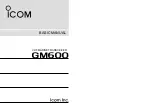
4 - 2
4-2 TRANSMITTER CIRCUITS
4-2-1 MICROPHONE AMPLIFIER CIRCUIT
(MAIN UNIT)
The microphone amplifier circuit amplifies audio signals with
+6 dB/octave pre-emphasis from the microphone to a level
needed at the modulation circuit.
The AF signals from the microphone are amplified at
the microphone amplifier (IC10A) via the analog switch
(IC7A, pins 1, 2). A capacitor (C223) and resistor (R171)
are connected to the amplifier to obtain the pre-emphasis
characteristics.
The amplified signals are applied to the IDC amplifier and
are passed through the splatter filter (IC10B, pins 5–7) to
suppress unwanted 3 kHz or higher signals. The filtered
signals are then applied to the modulation circuit.
4-2-2 MODULATION CIRCUIT (MAIN UNIT)
The modulation circuit modulates the VCO oscillating signal
(RF signal) using the microphone audio signals.
Audio signals from the splatter filter (IC10B) pass through
the frequency deviation adjustment pot (R184) and are then
applied to the modulation circuit (D11, D12) to change the
reactance of D11–D14 and modulate the oscillated signal at
the VCO (Q13, Q14).
4-2-3 DRIVE AMPLIFIER CIRCUIT (MAIN UNIT)
The drive amplifier circuit amplifies the VCO oscillating
signal to a level needed at the power amplifier.
The VCO output is buffer-amplified by Q15 and Q16, and is
then applied to the Tx/Rx switch (D16, D17). The transmit
signal from the Tx/Rx switch is amplified to the YGR (Q17)
amplifiers to obtain an approximate 10 mW signal level. The
amplified signal is then applied to the RF power amplifier
(IC4).
4-2-4 POWER AMPLIFIER CIRCUIT (MAIN UNIT)
The power amplifier circuit amplifies the driver signal to an
output power level.
IC4 is a power module which has amplification output
capabilities of about 25 W with 10 mW input. The output
from IC4 (pin 4) is passed through the antenna switching
circuit (D1) and is then applied to the antenna connector via
the low-pass filter.
4-1-5 AF AMPLIFIER CIRCUIT
(MAIN AND FRONT UNITS)
The AF amplifier circuit amplifies the detected signals to
drive a speaker. The AF circuit includes an AF mute circuit
for the squelch.
AF signals from IC1 (pin 9) are applied to the de-emphasis
circuit (R61, C89). The de-emphasis circuit is an integrated
circuit with frequency characteristic of –6 dB/octave.
The integrated signals pass through the Band-pass filter (Q6,
Q7, R62–R70, C90–C94) to suppress unwanted lower noise
signals.
The filtered signals are applied to the AF mute circuit (IC7B),
and then passes through the [VOLUME] control (VR board;
R1) via the “VOL1” signal. The signals are applied to the AF
power amplifier (IC6, pin 1). The output signal from IC6 (pin4)
drives the internal (external) speaker.
4-1-6 SQUELCH CIRCUIT
(MAIN UNIT, LOGIC AND SQL BOARDS)
A squelch circuit cuts out AF signals when no RF signals
are received. By detecting noise components in the AF
signals, the squelch circuit switches the AF mute switch.
A portion of the AF signals from the FM IF IC (IC1, pin 9)
pass through the squelch adjustment volume (SQL board;
R1), and are then applied to the active filter section (IC1,
pin 8). The active filter section amplifies and filters noise
components. The filtered signals are applied to the noise
detector section and output from pin 13 as the “SQL” signal.
The “SQL” signal is applied to the CPU (LOGIC board; IC1,
pin 30). The CPU analyzes the noise condition and outputs
the “RMUTE” signal to toggle the AF mute switches (IC7B).
AF
MUTE
BPF
IC6
R1
IC7
Q5
External SP
Internal SP
(FRO T unit)
HVS
AF
Amplifier
The detected signal from
the FM IF IC (IC1, pin 9)
de-emphasis
circuit
R61
C89
(VR board)
• AF CIRCUITS










































